| A | B |
|---|
| Pangaea is just the latest of several _______ that formed during the history of Earth. It was a huge landmass that existed between 200 and 300 million years ago when all of the continents were basically stuck together. | supercontinents, 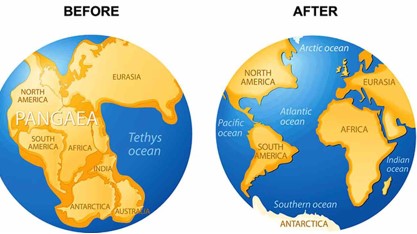 |
| _____ is just the latest of several supercontinents that formed during the history of Earth. It was a huge landmass that existed between 200 and 300 million years ago when all of the continents were basically stuck together. | Pangaea,  |
| TRUE or FALSE: The fact that fossils of the same species can be found on 2 different continents separated by ocean as long as they are between 200 and 300 million years old was evidence supporting the hypothesis of continental drift. | TRUE (During the time period between 200 and 300 million years ago, the continents were all stuck together into one giant supercontinent called Pangaea. Therefore it is not surprising that the same species' fossils can be found on more than one continent today as long as they lived during the time period that Pangaea was together), 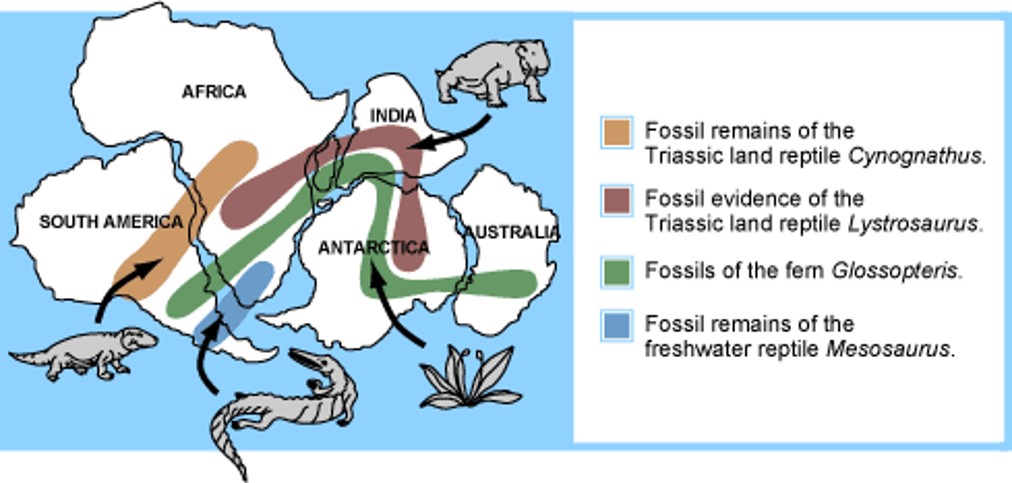 |
| TRUE or FASLSE: Fossils of Reptiles (a cold blooded animal) have NEVER been found in cold places like Antarctica. | FALSE (Cold blooded animal fossils have been found in Antarctica, indicating that the climate in Antarctica wasn't always so cold. This can best be explained by continental drift which makes it possible that Antarctica was once much closer to the equator) |
______ causes mid-ocean ridges (like the one in the Atlantic shown below) to form.,  | Sea floor spreading, 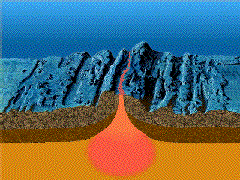 |
Sea floor spreading causes _________ (like the one in the Atlantic shown below) to form.,  | mid-ocean ridges,  |
| The further the rocks are from a mid-ocean ridge, the _____ the rocks are. | older (If you look at the animation here of sea floor spreading at a divergent plate boundary, it is easy to sea why the newest rock has just come out as magma and quickly hardened. Rock further away from the ridge would have done that earlier),  |
| The closer the rocks are from a mid-ocean ridge, the _____ the rocks are. | younger, 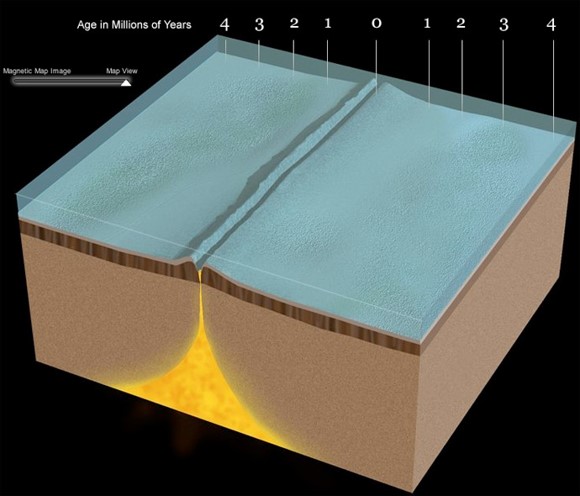 |
You would expect point B on the left side of the mid-ocean ridge to be _____ million years old., 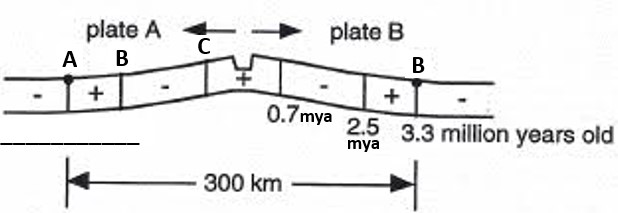 | 2.5 million (Notice how point B on the left side is the same distance from the ridge as the point on the right that says 2.5 mya (million years ago)? Since both are the same distance, they must have come out as magma and hardened at the same time. The animation below help you visualize that),  |
| What causes Earth Quakes? | A Chuck Norris flying side-thrust kick, of course!,  |
You would expect point A on the left side of the mid-ocean ridge to be _____ million years old.,  | 3.3 million years old (Notice how point A on the left side of the ridge is the same distance from the ridge as the point B the right that says 3.3 million years old. Since both are the same distance from the mid-ocean ridge, they must have come out as magma and hardened at the same time. The animation below help you visualize that),  |
The development of the theory of ______ provided an explanation for how continental drift occurs., 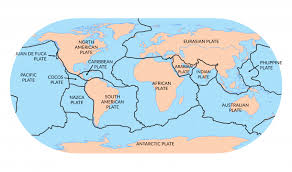 | plate tectonics (The theory explains how the Earth's lithosphere is made up of 7 major plates that "float" on top of the non-solid parts of the mantle which allows them to drift and bump into each other. Convections currents within the mantle provide some of the force necessary to move the plates.), 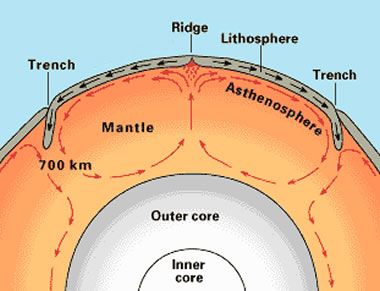 |
| The Earth’s lithosphere (made up of the crust and solid brittle upper part of the mantle) is broken into several blocks called tectonic _________. | plates,  |
| The Earth's _____________ is the solid brittle part on the surface made up of the crust and the solid brittle parts of the mantle. | lithosphere, .jpg) |
| The Earth's lithosphere is the solid brittle part of Earth's surface, made up of the _____ and the solid brittle parts of the _____. | crust, mantle, .jpg) |
| Most earthquakes take place at the boundaries of Earth's _____. | plates |
| A divergent boundary is a boundary in which two plates move ______ each other | away from,  |
| A ______ boundary is a boundary in which two plates move away each other. | divergent,  |
| Magma from the asthenosphere rises to the surface forming undersea mountain ranges known as ___________ at divergent boundaries. | mid-ocean ridges (like the mid-Atlantic ridge shown below),  |
Magma from the asthenosphere rises to the surface forming undersea mountain ranges known as mid-ocean ridges (like the mid-Atlantic one shown below) at ______ boundaries,  | divergent,  |
| A ______ boundary is a boundary in which two plates move toward each other. | convergent, 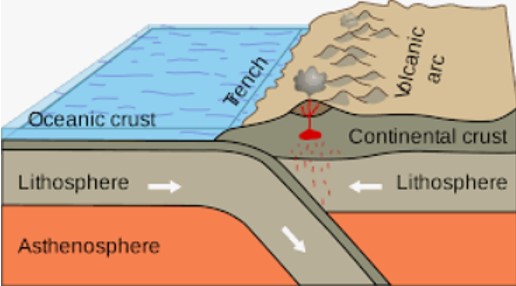 |
| A convergent boundary is a boundary in which two plates move _____ each other. | toward,  |
The type of boundary that is being shown in the picture below is a ____ boundary.,  | convergent, 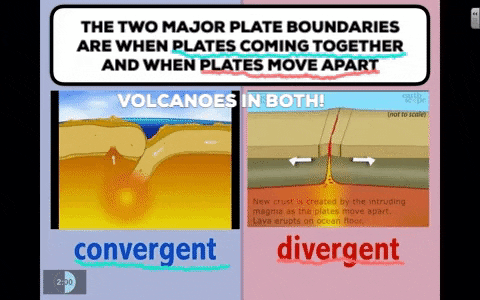 |
The type of boundary that is being shown in the picture below is a ____ boundary., 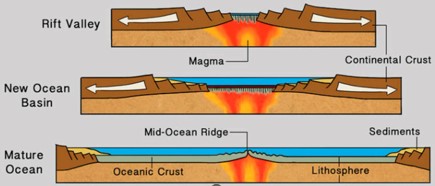 | divergent,  |
| The region along a plate boundary where one plate moves under another plate is called a _______. | subduction zone,  |
| When two plates collide head on, if one of the plates is more dense than the other, it will ______ under the other (use the technical term) | subduct (Notice that one plate on the left is is subducting under the plate on the right),  |
From this picture, it can be inferred that oceanic crust is ____ dense than contintental crust.,  | more (Oceanic crust IS more dense than continental crust, which is why it subducts under continental crust),  |
| Extremely deep regions of the ocean occur in subduction zones and are called _____. | deep-ocean trenches (The deepest on is the Mariannes trench whic at 35,814 feet deep is almost 7 miles under the surface of the ocean. If you were to sink the tallest mountain in the world, Everest, into the Marianes trench, there would still be over a mile of water above the summit. Mt. Everest has an elevation of 29,035 feet), 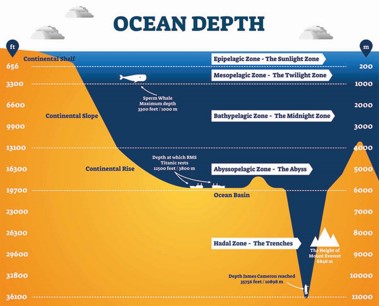 |
| The deepest parts of the ocean occur at ______ zones. | subduction (These areas are called deep ocean trenches. The deepest one, the Mariannes trench at 35,814 feet deep is almost 7 miles under the surface of the ocean. If you were to sink the tallest mountain in the world, Everest, into the Marianes trench, there would still be over a mile of water above the summit. Mt. Everest has an elevation of 29,035 feet),  |
| The type of plate boundary that causes volcano formation is a ______ boundaries. | convergent (The friction of the two plates sliding past each other plus the addition of water causes magma to form and rise through the crust, causing volcanoes to form), 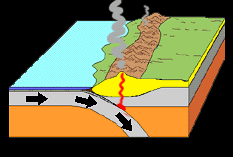 |
| When two continental plates of equal density collide, ______ can form. | mountain ranges, 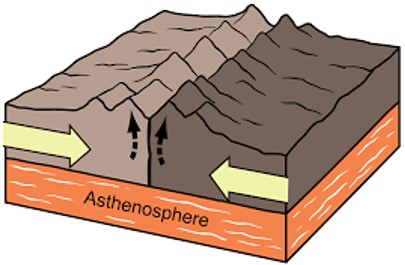 |
| Geologic ______ causes mountain ranges to form when two tectonic plates collide. | uplift (Geologic uplift, 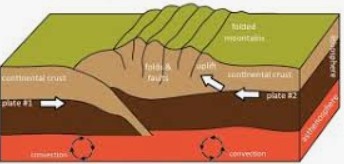 |
| A ____ boundary is a boundary in which two plates slide past each other horizontally. | transform, 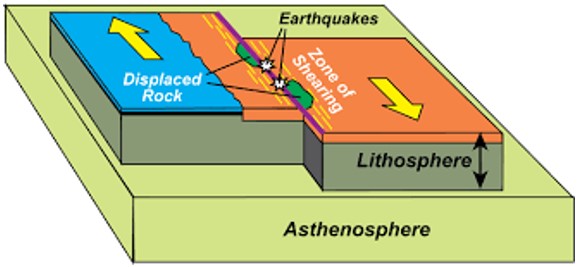 |
The type of boundary that is being shown in the picture below is a ____ boundary.,  | transform,  |
| The type of plate boundary at which strong earthquakes are most likely to form is a _____ boundary | transform,  |
| ____ are most likely to occur along transform boundaries. | Earthquakes,  |
| The movement of molten mantle through _____ currents is one of the major forces that cause tectonic plates to move. | convection, 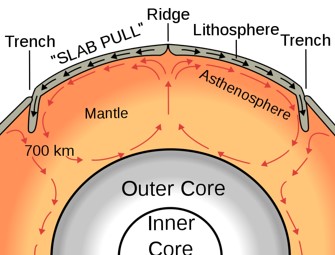 |